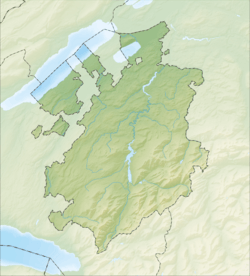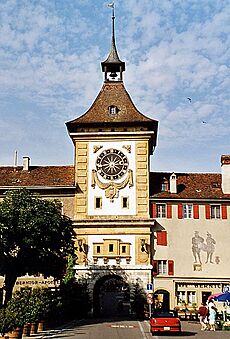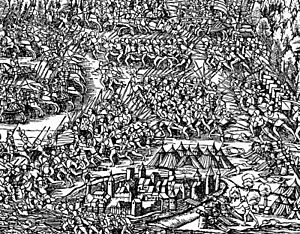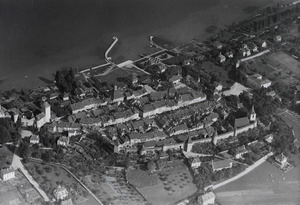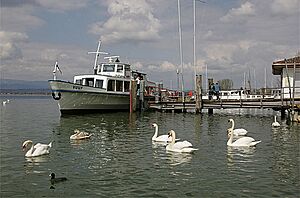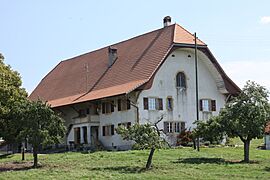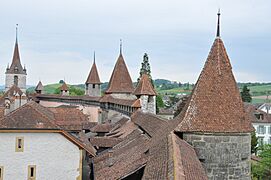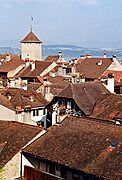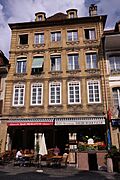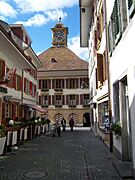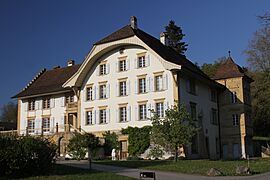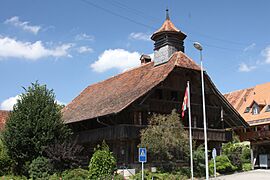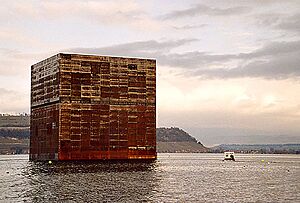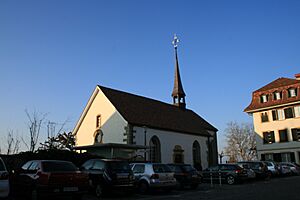Murten facts for kids
Quick facts for kids
Murten/Morat
|
||
|---|---|---|
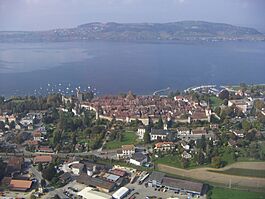 |
||
|
||
| Country | Switzerland | |
| Canton | Fribourg | |
| District | See | |
| Area | ||
| • Total | 24.7 km2 (9.5 sq mi) | |
| Elevation | 453 m (1,486 ft) | |
| Population
(Dec 2020 )
|
||
| • Total | 8,244 | |
| • Density | 333.8/km2 (864.4/sq mi) | |
| Postal code |
3280
|
|
| Surrounded by | Bas-Vully, Büchslen, Courgevaux, Galmiz, Greng, Haut-Vully, Lurtigen (Lourtens), Meyriez, Münchenwiler (Villars-Les-Moines) (BE), Muntelier, Müntschemier (BE), Ried bei Kerzers, Salvenach (Saalvagny) | |
Murten (also known as Morat in French) is a cool, historic city in Switzerland. It's located in the Fribourg canton, right on the southern shore of Lake Morat. This lake is also called Lake Murten.
Murten is special because it's a bilingual city. Most people (about 75%) speak German, even though the Fribourg canton mostly speaks French. The city is nestled between the bigger cities of Neuchâtel and Fribourg.
Over the years, Murten has grown by joining with several nearby towns. For example, Burg bei Murten joined in 1975, and more recently, Galmiz, Gempenach, and Clavaleyres became part of Murten in 2022.
Contents
History of Murten
Ancient Times and Roman Era
People have lived in the Murten area for a very long time! The oldest signs of human settlements are from the Mesolithic period, which was about 8,200 to 5,500 BC. Back then, people used small flint stones for their tools and weapons.
Later, during the Neolithic (5,500-2,500 BC) and Bronze Age (2,300-800 BC), more settlements appeared. Archaeologists have found ancient burial sites, some used for over a thousand years! There are also remains of a large Roman villa and a Roman road from around the 1st or 2nd century BC.
From Fortress to Free City
The name Murten comes from a Celtic word, moriduno, which means "lakeside fortress." The town was first mentioned in 515 AD as a defensive place called "Muratum." In 1013, King Rudolph III of Burgundy made the defenses even stronger.
The town was founded as a city around 1159 or in the 1170s/1180s. In 1238, Murten was officially called a city. For a while, it was even a "Free Imperial Town" under the German emperor Frederic II. However, it later came under the protection of the Counts of Savoy and the Habsburgs at different times. Murten started making alliances with other Swiss cities like Fribourg (in 1245) and Bern (in 1335). A big fire in 1416 led to many buildings being rebuilt with strong stone.
The Famous Battle of Morat
One of the most important events in Murten's history is the Battle of Morat. On June 22, 1476, Charles the Bold, the Duke of Burgundy, tried to capture the town. Murten bravely held out for 13 days! Finally, the army from Bern arrived and saved the town. The Burgundian army was completely defeated, with about 10,000 soldiers killed.
Since then, Murten celebrates this huge victory every year on June 22nd. It's a very special day for the city!
From 1484 onwards, Murten was ruled by two cantons: Bern and Fribourg. This lasted for 300 years. In 1530, Murten became Protestant after the preacher Guillaume Farel shared the new faith. This often caused disagreements with Fribourg, which remained mostly Catholic.
In the late 1600s, Murten became rich from trade. Goods traveled through the city on roads and along the Broye river. Many houses in the city were rebuilt during this time, showing off the new wealth.
Modern Era and Growth
After the French invasion in 1798, Murten became part of the Fribourg canton in 1803.
Industrialization started in Murten in the 1850s with a watch factory. Other businesses like an absinthe distillery and a winery also opened. Murten even got its own newspaper, the "Murtenbieter," in 1855. In the 20th century, more industries came to Murten, especially in areas like precision engineering, electronics, and food. The Swiss Federal Railways also bought Löwenberg Castle to create a training center.
At first, Murten missed out on a main railway line, which affected its income. But later, in 1875-76, the Palézieux-Murten-Lyss railway line was built. More railway lines followed, connecting Murten to Fribourg and Ins. Steamship service on Lake Murten also began in 1835, helping with transportation and trade. Tourism also started to grow, especially after the 400th anniversary of the Battle of Morat in 1876.
Geography and Nature
Murten/Morat covers an area of about 12 square kilometers (4.6 square miles). A little over half of this land (51.4%) is used for farming, while about a quarter (26.2%) is covered by forests. The rest is made up of buildings, roads, and a small amount of rivers or lakes.
The charming medieval town sits on a gentle hill, about 450 meters (1,476 feet) above sea level, right on the shore of Lake Morat. You can still see many historic features like the old castle, the city walls, and the unique arcades along the streets.
Lake Morat is a smaller lake located between two larger lakes, Lake Biel and Lake Neuchâtel.
On the western side of the region, you'll find Mont Vully. This mountain is known for its vineyards, which cover over 100 hectares (247 acres) on its sunny southern side, facing Lake Morat. Long ago, ancient Celtic tribes enjoyed the mild climate and beautiful scenery of this area.
Murten is also famous for its well-preserved ramparts (city walls) and towers, which remind everyone of its past as a fortified city.
Coat of Arms
The blazon (description) of Murten's coat of arms is: a red lion standing on its hind legs, wearing a gold crown, on green hills, all on a silver background.
Population and Languages
Murten has a population of around 6,000 people. About 19% of the people living here are from other countries.
Most people in Murten (about 76.5%) speak German as their main language. French is the second most common language (about 12.8%), and Italian is third (about 1.9%).
Looking at the age groups, children and teenagers (up to 19 years old) make up about 23% of the population. Adults (20-64 years old) are the largest group at about 61%, and seniors (over 64 years old) make up about 15.7%.
Here's how the population has changed over time:

Important Historic Sites
Murten has several buildings and areas that are considered very important heritage sites. These include:
- The farm house at Erli 2
- Murten's old city walls
- The Grosshaus at Hauptgasse 43
- The Rathaus (town council house)
- Löwenberg Castle
- The Old School House in Salvenach
The entire old city of Murten and the village of Lurtigen are also part of the Inventory of Swiss Heritage Sites, meaning they are specially protected for their historical value.
UNESCO World Heritage Site
An area near the Segelboothafen (sailboat harbor) is part of the Prehistoric Pile dwellings around the Alps UNESCO World Heritage Site. This means it's recognized globally as a very important historical place.
This site has remains of ancient pile-dwelling settlements from the Middle and Final Neolithic period (around 3552 BC and 2534 BC). Archaeologists have found pottery, stone tools, wooden objects, and animal bones here, giving us clues about how people lived thousands of years ago.
Economy and Jobs
Murten has a low unemployment rate, which is good! In 2010, it was about 3.1%.
The economy is divided into three main parts:
- Primary sector: This includes jobs like farming and forestry. About 105 people work in this area.
- Secondary sector: This involves manufacturing (making things in factories) and construction. About 1,374 people work here.
- Tertiary sector: This is the largest sector and includes jobs in services, like sales, transportation, hotels, restaurants, finance, education, and healthcare. About 2,263 people work in this sector.
Many people who live in Murten also work in other towns, and many people from other towns come to Murten for work. About 53% of workers use a private car to get to work, while 11.3% use public transportation.
Religion
In Murten, about 30% of the people are Roman Catholic, and about 47.7% belong to the Swiss Reformed Church (a Protestant church). There are also smaller groups of people who follow other Christian faiths, Islam, Buddhism, and Hinduism. About 8% of the population doesn't belong to any church.
Weather
Murten usually has about 126 days of rain or snow each year, with an average of 995 millimeters (39 inches) of precipitation. June is often the wettest month, with about 106 mm (4.2 inches) of rain or snow over 11 days. May has the most days with precipitation (around 13.3 days), but February is the driest month, with about 67 mm (2.6 inches) of precipitation over 10 days.
Education
Education is important in Murten! About 37.9% of the adult population has completed upper secondary education (like high school), and 14.5% have gone on to higher education, such as university.
The Fribourg school system works like this:
- One year of optional Kindergarten.
- Six years of Primary school.
- Three years of required lower Secondary school, where students are grouped by their abilities.
- After that, students can choose to go to an optional three or four-year upper Secondary school. This can be a gymnasium (which prepares students for university) or a vocational program (which teaches job skills).
- After upper Secondary, students can go to a Tertiary school (like a university) or continue with an apprenticeship (on-the-job training).
In the 2010-2011 school year, there were 178 kindergarten students and 601 primary school students in Murten. There were also 623 students in lower secondary school. Many students from Murten also attend schools in other towns, and students from other towns come to Murten for school.
Transportation
Murten is well-connected by train! The city has two railway stations: Murten/Morat and Muntelier-Löwenberg. These stations are on the Fribourg–Ins and Palézieux–Lyss lines. You can catch regular trains to cities like Lausanne, Fribourg/Freiburg, Neuchâtel, and Bern.
Notable people
- Jeremias Gotthelf (1797 in Murten – 1854): A famous Swiss novelist.
- Gaston Mullegg (1890 in Murten – 1958): President of the International Rowing Federation for many years.
- Teddy Stauffer (1909 in Murten – 1991): A Swiss bandleader, musician, actor, and nightclub owner.
- Nuno Reis (born 1991 in Murten): A professional footballer from Portugal.
See also
 In Spanish: Murten para niños
In Spanish: Murten para niños




